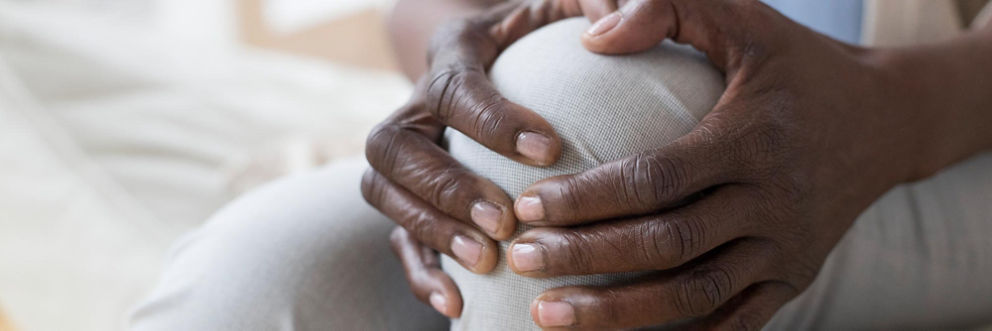Knee replacement surgery
World class knee replacement surgery at TRIA
If you struggle with a chronic knee condition, you know there’s more to it than pain and stiffness. A bad knee can keep you from doing the things you love. If you’re ready to get back on your bike, dance the night away or simply tackle a flight of stairs again, a knee replacement may be an option for you.
Our team of orthopedic surgeons, physical therapists and other specialists are leading experts in the Midwest, with knee replacement outcomes that exceed the national average.
We use the latest surgical and rehabilitation techniques such as the ROSA® Knee robotic technology to help our patients recover as quickly and comfortably as possible – with many of our patients safely returning home the same day. With personalized care and expertise, we’re here to answer questions, help you decide if knee replacement is right for you, and determine what type of surgery will help you best accomplish your goals.
"Because of your surgical artistry and motivation in [physical therapy], I was able to get back to every activity I did before, except now I am the strongest I've ever been athletically."
Why are knee replacements needed?
The knee is protected by cartilage, a smooth, rubbery tissue that cushions the joint. If the cartilage in your knee becomes worn or damaged, moving your knee can become painful. Knee replacements can be used to treat severe cases of
A knee replacement or partial knee replacement surgery replaces the injured knee joint with an artificial one. An artificial knee can correct alignment issues, reduce stiffness, ease pain and improve mobility.
We’ll only recommend a knee replacement if other nonsurgical treatment options don’t work to manage your symptoms.
How to know if you need a knee replacement
The best way to know if a knee replacement is the right treatment for you is to talk to an orthopedist. However, consider talking to your doctor if you notice any
- Your knee pain no longer responds to nonsurgical treatments
- Your knee pain is getting more intense and frequent
- Your mobility has become increasingly limited
- You notice consistent or recurring swelling in your knee
- You’re not able to do the things you love
Types of knee replacements
We perform four different types of knee replacement surgery.
Partial knee replacement
During a partial knee replacement, also called unicompartmental knee replacement, only part of your knee is replaced. This surgery is used when knee damage is limited to one compartment of the knee, the knee ligaments are intact and there aren’t significant alignment issues.
We’ll only remove the damaged cartilage and leave the healthy tissue in place. This enables us to make a smaller incision, meaning partial knee replacement has a quicker recovery time than total knee replacement.
Total knee replacement
A total knee replacement, also called total knee arthroplasty, is a type of knee replacement surgery where your entire knee is replaced with an artificial one. During the procedure, we’ll remove the knee cartilage and resurface the kneecap to fit perfectly with the artificial joint.
Total knee replacements are used to treat knee pain that interferes with sleep and other daily activities. This type of knee replacement surgery is typically recommended if other surgeries have been ruled out.
Knee replacement revision surgery
Artificial knees can last more than 20 years, but ordinary use can cause them to wear out over time. In some cases, a knee replacement revision is needed to fix a damaged artificial knee. In rare cases, a revision surgery may be needed if there is an infection, a complication from surgery, or if the knee replacement surgery didn’t resolve your knee issues.
During a revision, we’ll replace the damaged parts of the artificial joint with new pieces. Depending on the condition of the joint, we may need to replace the entire joint or only part of it.
The likelihood that you’ll need revision surgery depends on many different factors, including the age you are when you have your knee replaced. People who get a knee replacement at a younger age are more likely to need a revision. If you have any questions about knee replacement revisions, ask one of our orthopedic surgeons.
Patellofemoral replacement surgery
Patellofemoral replacement surgery replaces the area under the surface of the kneecap and the groove under the kneecap (trochlea). This surgery is the most effective option when the damaged tissue only affects the under-surface of the kneecap.
Because only part of the knee is replaced during patellofemoral replacement surgery, it has a quicker recovery time than total knee replacement surgery.
Robotic-Assisted Total Knee Replacement
When you trust your knee replacement to TRIA, you have access to some of the newest technologies such as the
ROSA gives your surgeon the real-time information they need to plan for and carry out a total knee replacement that is based on your unique anatomy. A good implant fit is key to a full and comfortable recovery. During your procedure, ROSA uses live cameras and optical lens tracking to follow the exact position of your leg. If your leg moves even a millimeter, ROSA adjusts to allow the most accurate placement of the implant.
With the latest surgical technology, like ROSA, and contemporary rehabilitation programs, we help you recover as quickly and comfortably as possible.
Knee replacement recovery
Whenever possible, our patients return home the same day or the day after surgery. We may recommend assistive devices – crutches, walkers, raised toilet seats and tub chairs – to make your recovery more comfortable. Other devices, including post-operative icing machines, can make some parts of your recovery plan easier.
Throughout your recovery, you’ll meet with your orthopedic surgeon, physical therapist and others from your care team to check how you’re healing. We’ll be by your side every step of the way.

Hotel Recovery Program
When going directly home after a knee replacement isn’t an option, recovering at a comfortable hotel might be just what you need. Our Hotel Recovery Program is more affordable than an overnight hospital stay, and you’ll get high-quality care brought directly to your private room.
Physical therapy after a knee replacement
Movement is key to a successful recovery, which is why your first physical therapy session will be as soon as possible after your knee replacement surgery.
During your
